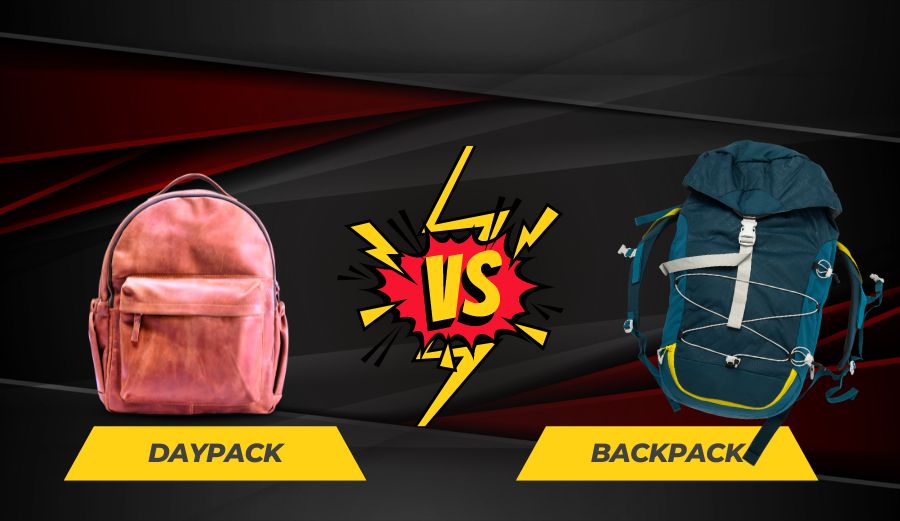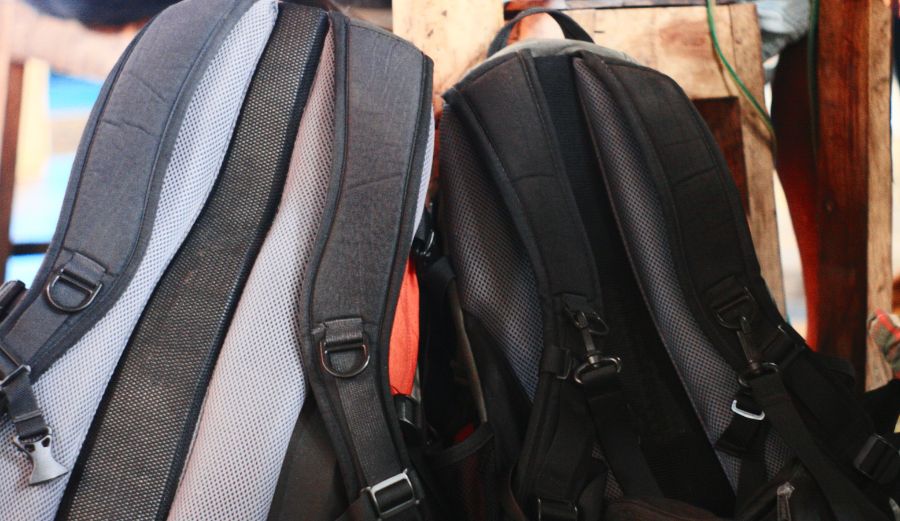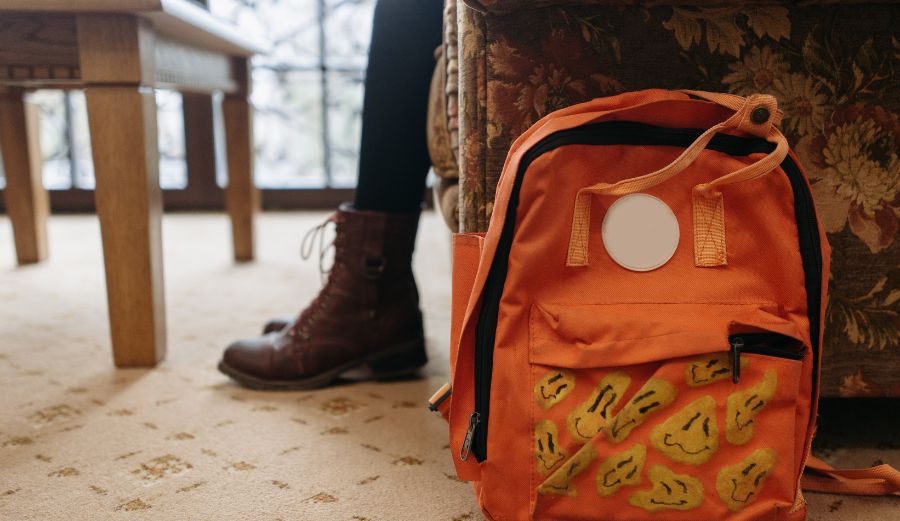Daypack Vs Backpack: The Gear Guru's Dilemma in 2023
Understanding the distinction between Daypacks and Backpacks is crucial for choosing the right travel companion. Whether exploring the city or embarking on an outdoor adventure, this knowledge ensures you pick the ideal bag to meet your needs, enhancing comfort and convenience.

Imagine standing at the threshold of adventure, eager to explore the great outdoors. You’re enthusiastic, but there’s one pressing question: Daypack Vs Backpack—which should accompany you on your journey? It’s a conundrum that often leaves explorers perplexed. The choice between these two stalwart companions can make or break your expedition.
In this informative guide, we’ll navigate the intricacies of daypacks and backpacks, shedding light on their nuances and helping you make an informed decision. So, whether you’re a seasoned trekker or a novice adventurer, let’s embark on this enlightening quest to discover the perfect carry companion for your escapades.
Table of Contents
ToggleDefining Daypacks and Backpacks

Let’s get our terminology straight before we delve deeper into the daypack vs. backpack dilemma.
Daypack: At its core, a daypack is a smaller, more lightweight version of a backpack. Picture it as the sprinter among bags designed for shorter, day-long adventures. It’s your trusty sidekick for carrying essentials during daily commutes, spontaneous urban escapades, or a leisurely day hike. Often ranging from 15 to 35 liters in capacity, it’s a versatile choice.
Backpack: Conversely, a bag is a heavyweight champion, built to endure extended journeys and heavier loads. These sturdy companions, typically larger than daypacks, come with robust frames and greater carrying capacities. They’re your go-to for multi-day camping trips, epic global odysseys, or any adventure that demands substantial gear.
Debunking the Confusion
Let’s debunk a common misconception: these two are different. While they share the common denominator of being strapped to your back, their purposes are distinct. It’s like comparing a sprinter’s lightweight shoes to a mountaineer’s heavy-duty boots—they both have their place, but choosing the right one is crucial.
Daypacks are nimble, perfect for quick getaways and keeping your hands free during urban explorations. Backpacks, on the other hand, excel when you need to haul substantial gear for extended periods, such as week-long camping excursions or globe-trotting adventures.
Understanding these differences is paramount because selecting the right companion will significantly impact your comfort and convenience on your escapades. So, let’s continue our journey and explore the nuances that will help you make an informed choice.
Characteristics of a Daypack

Size Matters (15L – 35L)
Imagine Goldilocks searching for the perfect bag: not too big or small, but just right. That’s precisely what a daypack delivers in terms of size. Ranging from 15 to 35 liters in capacity, it strikes the ideal balance between spaciousness and portability. Whether you’re toting a laptop, water bladder, or a day’s essentials, there’s room to spare.
Featherlight Design
If there’s one rule daypacks abide by, it’s “lighter is better.” Crafted with minimalism in mind, they shed unnecessary bulk to keep you agile and carefree. These featherlight companions are your ticket to hands-free mobility, whether strolling through town or embarking on a scenic day hike.
Budget-Friendly Elegance
Ever heard the saying, “You don’t need to break the bank to look good”? Daypacks wholeheartedly embrace this philosophy. They will satisfy your wallet like their bulkier backpack siblings. With entry-level options starting at around $40, daypacks offer affordability without compromising style or functionality.
Back Support, Minimally
In the daypack universe, less is more regarding back support. While they may include some padding for comfort, daypacks generally lack the internal frames found in backpacks. Their compressible and packable nature caters to shorter excursions rather than marathon treks.
Shoulder Straps: Less is More
As you wouldn’t load a featherweight with bricks, daypacks are meant for something other than Herculean endeavors. Hence, they forgo the heavily padded shoulder straps that backpacks sport. However, you’ll find a small hip and sternum strap to keep your daypack close and steady during your outings.
Top-Loading Prowess
Daypacks unveil their magic through their top-loading design. This user-friendly feature grants quick access to essentials while you’re on the move. Need your camera, granola bars, or that well-deserved sip from your water bladder? Just reach the top, and you’re all set.
Material Variety
From canvas to leather and various synthetic materials, daypacks offer a smorgasbord of choices to match your style and needs. Whether you crave urban elegance or rugged outdoor durability, there’s a daypack material that suits your taste.
Style, Unleashed
Daypacks are the chameleons of the bag world. Equally at home on a hiking trail, in a coffee shop, or at your workplace, they exude versatility. Manufacturers understand that your style is as unique as your adventures, so they churn out various designs to cater to every taste.
These characteristics combine to create a daypack that’s not just a bag but a reliable companion for your day-to-day pursuits, ensuring you’re always prepared for the next adventure, big or small.
Characteristics of a Backpack

Size: For the Long Haul
Regarding backpacks, think “bigger is better” for those extended journeys. These robust companions offer a larger capacity, making them ideal for multi-day camping expeditions, epic around-the-world travels, or any adventure demanding substantial gear. With the capacity to comfortably haul 25 pounds or more, backpacks are your trusted partner for the long haul.
Built to Last
Backpacks are the workhorses of the bag world. They’re crafted for durability and sturdiness, built to withstand the rigors of extensive travel and outdoor escapades. Unlike their smaller counterparts, backpacks prioritize robust construction to withstand time and rough terrain.
Investment Considerations
With great capacity and durability comes a higher price tag. Backpacks are a more substantial investment compared to daypacks. While you can find budget-friendly options, those planning extensive or rugged adventures often opt for pricier models to guarantee longevity and performance.
Back Support: Your Backbone
An internal frame is the unsung hero of backpacks, providing crucial back support. This frame helps distribute weight evenly, reducing the strain on your body during long treks. Whether navigating steep mountain trails or conquering urban jungles, the internal structure has your back.
Shoulder Straps: Padded for Comfort
In contrast to daypacks, backpacks come equipped with generously padded shoulder straps. These straps ensure that even hefty loads feel manageable. Comfort during extended wear is a top priority for packs, making them indispensable for those carrying substantial gear.
Access From Every Angle
Backpacks are designed for convenience. They offer multiple access points, including side openings and bottom compartments, allowing you to organize your gear efficiently. This accessibility is invaluable when retrieving specific items without unpacking your entire bag.
Battle the Elements
Weather can be unpredictable, especially during outdoor adventures. Backpacks are often constructed from weather-resistant materials, protecting your gear against rain, snow, and other elements. These bags are designed to keep your belongings dry, ensuring your journey remains comfortable.
Functionality Over Fashion
While daypacks excel in the style department, backpacks prioritize functionality. Their utilitarian design ensures you have all the necessary features for extensive travel or outdoor expeditions. While they may not win fashion awards, packs are unbeatable regarding performance.
In summary, backpacks are the heavyweight champions of the bag world, ready to accompany you on extended adventures with their durability, ample space, and comprehensive back support. Whether you’re conquering rugged terrain or globe-trotting, a backpack is your trusted partner in exploration.
The Dilemma: Daypack or Backpack?

When choosing between a daypack and a backpack, it’s essential to consider several key factors that will significantly impact your outdoor experience. Let’s delve into these common considerations to help you make the right decision.
Purpose of the Trip
The primary purpose of your journey plays a pivotal role in determining whether a daypack or backpack is the better fit. Suppose you’re planning a short day hike, a daily commute, a visit to the coffee shop, or an urban adventure. In that case, a daypack is your go-to companion. Its compact size and lightweight design make it ideal for these activities. On the other hand, if your experience involves multi-day camping trips, extensive travel, or any scenario requiring substantial gear, a backpack is the way to go.
Expected Load and Duration
Consider the load you’ll be carrying and the duration of your adventure. If you’re inclined to pack light and prefer a hassle-free, lightweight experience, lean towards a daypack. They are designed for minimalistic adventures, encouraging you to carry only the essentials. With their larger capacity, backpacks are tailored for extended trips, accommodating everything you need for multi-day excursions. Packing for a weekend getaway? Opt for a backpack. Are you heading out for a day of exploration? Grab your trusty daypack.
Budget Constraints
Your budget is another critical factor. Daypacks are budget-friendly, often costing around $40 for an entry-level model. Backpacks, especially those from reputable brands like Osprey, North Face, or Fjallraven, can be considerably more expensive. A quality backpack may be a wise choice for extended adventures for durability and comfort. However, for those looking for an economical option for short trips, a daypack is a cost-effective solution.
Comfort and Back Health
Comfort and maintaining your back health are paramount, especially when outdoors. Daypacks are not designed for heavy loads or extended wear, offering minimal back support. While they may include some padding, they lack the internal frame crucial for extended comfort. Backpacks, conversely, provide excellent back support through their internal frames, padded shoulder straps, and hip belts. If you’re prone to back pain or planning long hikes, prioritize the well-being of your back and opt for a backpack.
Personal Style and Preferences
Personal style and preferences can also influence your decision. Daypacks are more stylish and versatile, often doubling as urban fashion statements. They come in various designs and colors to match your aesthetic. While focusing on functionality, backpacks may not win style awards but excel in performance. You may choose a sleek daypack that seamlessly transitions from the trail to the coffee shop or a rugged backpack built for the wild.
So, the daypack vs. backpack dilemma hinges on your specific needs, preferences, and the nature of your adventure. Consider the purpose of your trip, expected load, budget, comfort requirements, and personal style when making your decision. Remember that having both in your gear arsenal can provide the versatility to tackle various outdoor and urban scenarios effectively.
When to Use Each

Now that we’ve dissected the differences between daypacks and backpacks, let’s explore the practical scenarios where each trusty companion shines.
When to Use a Daypack:
Day Hikes: Daypacks are tailor-made for day hikes. Their lightweight design and sufficient capacity (15L – 35L) allow you to carry water, snacks, a first-aid kit, and essential gear without weighing you down. They’re ideal for exploring trails, offering quick access to your necessities while keeping your hands free to capture the beauty of nature.
Urban Outings: Whether strolling through the city, visiting museums, or shopping, a daypack is a stylish and practical choice. It can hold essentials like water, a jacket, a wallet, and even a camera, making it versatile for urban adventures.
Commutes: Many urban dwellers use daypacks for daily commutes. They accommodate laptops, books, and work essentials while remaining comfortable during your journey to and from the office.
Quick Trips: If you plan a short getaway for a weekend or a day at the beach, a daypack can carry your beach towel, sunscreen, snacks, and a good book. Its size and lightweight nature make it an excellent choice for these brief escapes.
Light Adventures: Daypacks are perfect companions for light outdoor adventures like picnics, bike rides, or exploring local parks. They provide enough space for your gear while ensuring you stay agile and mobile.
Real-World Tips for Optimizing Daypack Use:
- Organize Wisely: Use smaller pouches or packing cubes to keep your items organized within your daypack. This makes it easier to access what you need without rummaging through the entire bag.
- Hydration Matters: Invest in a daypack with a dedicated hydration sleeve or use a water bladder to stay hydrated during hikes.
- Safety First: Ensure your daypack has a dedicated compartment or pocket for essential items like your phone, keys, and wallet to prevent loss.
- Adjust and Secure: Use the sternum strap and hip belt, if available, to secure your daypack close to your body, preventing it from bouncing around while you hike or commute.
When to Use a Backpack:
Multi-Day Camping Trips: Backpacks are essential for multi-day camping adventures. Their larger size accommodates camping gear, clothing, and food, ensuring you have everything you need for an extended stay in the great outdoors.
Heavy Loads: When you need to carry substantial gear or supplies, such as photography, backpacking, or backcountry skiing, a backpack with robust construction and an internal frame is the way to go.
Weather Challenges: Backpacks are designed with weather-resistant materials to protect your gear from the elements. They’re your best bet for adventures where you might encounter rain, snow, or rugged terrain.
Real-World Tips for Optimizing Backpack Use
- Proper Weight Distribution: One of the most critical aspects of using a backpack is distributing weight evenly. Heavy items should sit close to your back, centered in the pack. This keeps your center of gravity stable and minimizes strain on your shoulders and lower back. Lighter items can be placed toward the outside of the bag.
- Adjust Your Straps: Before hitting the trail, take the time to adjust your backpack’s shoulder straps, hip belt, and sternum strap. A well-fitted pack can make a difference in comfort and load-bearing capacity. If you need help adjusting your backpack, ask for help at an outdoor gear store.
- Pack Smart: Organize your gear logically within the backpack. Heavy and frequently used items should be easily accessible at the top or in external pockets. Keep your sleeping bag, clothes, and other essentials in the main compartment. Use compression straps or packing cubes to save space and keep things tidy.
- Hydration Management: If your backpack has a hydration reservoir sleeve, use it. Staying hydrated is crucial, especially on long hikes. Ensure your water reservoir is easily accessible and adequately secured.
- Trail Etiquette: When on the trail, be mindful of your surroundings and fellow hikers. Keep your backpack close to your body to avoid accidentally brushing against vegetation or other hikers.
- Emergency Essentials: Always carry essentials like a first-aid kit, headlamp, and multi-tool in an easily accessible pocket or compartment. You never know when you might need them.
Personalization and Features: Tailoring Your Choice

Personalization is the key to finding the perfect match for your needs when choosing between a daypack and a backpack. Here, we’ll explore how to personalize your choice by considering additional features and aligning your selection with your unique preferences:
1. Additional Features:
a. Compartments: Depending on your activities, you may require specialized compartments. If you’re a photographer, seek a backpack with padded dividers and dedicated camera compartments. For hikers, compartments for snacks, maps, or a first-aid kit can be invaluable.
b. Hydration Compatibility: Staying hydrated during outdoor adventures is essential. Many daypacks and backpacks come with hydration reservoir sleeves and tube ports, allowing you to sip water conveniently while on the move.
c. Laptop Sleeves: If you’re a digital nomad or need to stay connected during your adventures, consider a backpack with a dedicated laptop sleeve. It ensures your electronic devices stay safe and secure.
2. Aligning with Your Needs and Preferences:
a. Activity-Specific Choices: Tailor your selection to match your primary activities. If you’re an urban commuter, a daypack with a laptop sleeve and organized compartments for work essentials might be ideal. Features like gear loops and attachment points for trekking poles can be essential for outdoor enthusiasts.
b. Comfort and Fit: Everyone’s body is different, so choose a daypack or backpack that fits you comfortably. Adjustable straps, padded hip belts, and ergonomic designs provide a comfortable fit during long hikes or extended travels.
c. Style and Aesthetics: Remember to consider the importance of style. Many brands offer a variety of colors and designs, allowing you to express your personal taste while staying practical. Whether you prefer a sleek urban look or a rugged outdoor aesthetic, there’s a pack that suits your style.
D. Seasonal Considerations: Consider the seasons in which you’ll be using your pack. For winter adventures, look for backpacks that accommodate extra layers and equipment. Consider ventilation options for hot summer hikes.
e. Budget and Value: Determine your budget and seek packs that offer the best value within your price range. Remember that a well-constructed pack with the right features can be a worthwhile investment for your outdoor endeavors.
So, personalization goes beyond choosing between a daypack and a backpack. It involves considering additional features that align with your specific needs and preferences. Whether you prioritize compartments, hydration compatibility, laptop sleeves, or other features, personalizing your choice ensures that your pack becomes an indispensable companion tailored to your unique adventures. So, pick the daypack or backpack that not only carries your gear but also reflects your personality and enhances your outdoor experiences.
Final Thoughts: A Journey Shared
As the discussion about backpacks unfolds, my thoughts wander back to a memorable journey I embarked on in the enchanting woodlands of the Pacific Northwest. Armed with my trusty daypack, I embarked on a solo hike through towering evergreens and along babbling brooks. It was a day filled with serenity and solitude, and my daypack was the perfect companion. It carried my essentials, allowing me to savor the natural world’s beauty.
But life is an ever-evolving adventure, and so are our needs. Eventually, my longing grew for more extended expeditions and more epic adventures. That’s when the backpack came into play. It bore the weight of my dreams, enabling me to explore distant lands, embrace diverse cultures, and find new perspectives.
My parting advice to you, dear reader, is this: cherish the diversity of your adventures, for they are the chapters that compose your life story. Whether you choose a daypack or a backpack, remember that these are not mere bags; they are companions on your journey, steadfast allies in your quest for exploration.
In the grand tapestry of outdoor experiences, there’s room for the daypack’s nimbleness and the backpack’s endurance. Embrace them for what they are: tools that empower your adventures, each with a unique role.
As you venture forth into the wild or urban landscapes that beckon, may your choice of pack enhance your experiences, lighten your burdens, and amplify your joy. The world is waiting; your next adventure is just a pack away. Happy trails!
FAQs
What is a Good Size Daypack?
A typical daypack holds 21 – 35 liters of goods.
What is the Best Daypack for Travelling?
The Osprey Daylite Plus is the finest daypack for traveling.
Is a 50-liter Backpack Enough?
Yes, a 50-liter bag is sufficient for camping and trekking, but if you are traveling or backpacking, you’ll need at least 50 liters.
Which is the Best Backpack Brand?
The North Face is the most reliable backpack brand on the market.
What is the best backpack for everyday use?
The “best” backpack is entirely subjective. There are hundreds of backpacks on the market, and I’m sure everyone has their list of favorites.
How Big is a 20L Backpack?
It’s challenging to picture how huge a 20L or 20-liter backpack is, especially if you’re browsing backpacks online.
When it comes to backpacks, a 20L bag is on the small side. Backpacks generally range in size from 20L to 80L for large hiking backpacks, to put this into perspective.
Sometimes the most straightforward approach to figure out how big something is is to compare it to comparable standard items. To put the proportions of a 20L backpack into perspective, consider a watermelon or an airtight balloon, which are about the same size as a 20L backpack.
Related Articles
